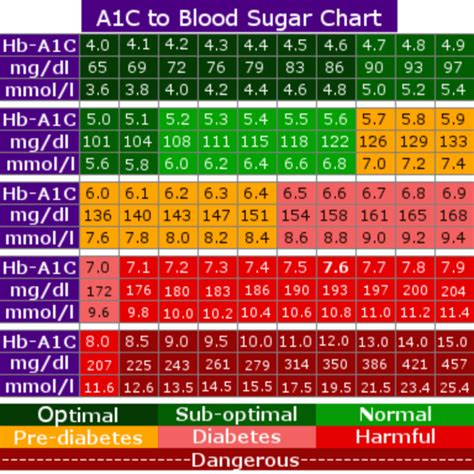The relationship between eag (estimated average glucose) and a1c (glycated hemoglobin) is a crucial aspect of diabetes management. For individuals living with diabetes, understanding this connection is vital for controlling blood sugar levels and preventing long-term complications. In this article, we’ll delve into the world of eag and a1c, exploring their significance, calculation methods, and the importance of monitoring these values.
To begin with, let’s define these two terms. A1c, also known as glycated hemoglobin, is a blood test that measures the average level of glucose (sugar) in your blood over the past 2-3 months. It does this by assessing the percentage of glucose that has bound to hemoglobin in red blood cells. On the other hand, eag (estimated average glucose) is a calculated value that correlates with a1c levels. It represents the average glucose level in the blood over a period, typically expressed in the same units as everyday glucose monitoring (mg/dL).
The eag value is calculated using the following formula: eag (mg/dL) = (28.7 * a1c) - 46.7. This formula allows healthcare providers to translate a1c values into a more familiar measure, making it easier for patients to understand their glucose control. For instance, an a1c of 7% corresponds to an eag of approximately 154 mg/dL. By using this conversion, individuals with diabetes can better comprehend their blood glucose levels and make informed decisions about their treatment plans.
Understanding the relationship between eag and a1c is essential for effective diabetes management. By monitoring these values, individuals can identify trends, patterns, and areas for improvement, enabling them to make data-driven decisions about their care.
One of the primary benefits of monitoring eag and a1c is the ability to assess glucose control over an extended period. This information can help healthcare providers adjust treatment plans, including medication, diet, and exercise regimens. Furthermore, eag and a1c values can serve as motivational tools, encouraging individuals to maintain good glycemic control and make lifestyle changes to improve their overall health.
When interpreting eag and a1c results, it’s essential to consider several factors that can influence these values. For example, red blood cell lifespan, hemoglobin variants, and certain medical conditions can affect a1c levels. Additionally, eag calculations may not accurately reflect glucose variability, making it crucial to use these values in conjunction with other monitoring tools, such as continuous glucose monitoring (CGM) or self-monitoring of blood glucose (SMBG).
Steps to Improve Glucose Control
- Set realistic targets: Work with your healthcare provider to establish achievable glucose targets.
- Monitor glucose levels: Regularly track your blood glucose levels using SMBG or CGM.
- Adjust medication: Collaborate with your healthcare provider to adjust your medication regimen as needed.
- Focus on lifestyle changes: Implement healthy lifestyle habits, such as a balanced diet and regular physical activity.
- Stay informed: Educate yourself about diabetes management and stay up-to-date with the latest research and recommendations.
In conclusion, the relationship between eag and a1c is a vital aspect of diabetes management. By understanding these values and how they relate to each other, individuals with diabetes can make informed decisions about their care and work towards achieving optimal glucose control. Remember to consult with your healthcare provider to determine the best approach for your specific situation and to develop a personalized plan for improving your eag and a1c levels.
What is the normal range for a1c levels?
+For individuals without diabetes, the normal range for a1c is typically below 5.7%. For those with diabetes, the American Diabetes Association recommends an a1c target of less than 7% for most adults.
How often should I check my a1c levels?
+The frequency of a1c testing depends on your individual situation and treatment plan. Typically, a1c levels are checked every 3-6 months, but your healthcare provider may recommend more frequent testing if you're experiencing changes in your glucose control or if you're adjusting your treatment plan.
Can I use eag and a1c levels to diagnose diabetes?
+While eag and a1c levels can provide valuable information about glucose control, they are not typically used to diagnose diabetes. Diagnosis is usually based on symptoms, medical history, and the results of blood glucose tests, such as the fasting plasma glucose (FPG) test or the oral glucose tolerance test (OGTT).
By embracing a comprehensive approach to diabetes management, individuals can harness the power of eag and a1c to achieve optimal glucose control and reduce the risk of long-term complications. Remember to work closely with your healthcare provider to develop a personalized plan that addresses your unique needs and goals. With the right tools, knowledge, and support, you can take control of your diabetes and improve your overall well-being.



